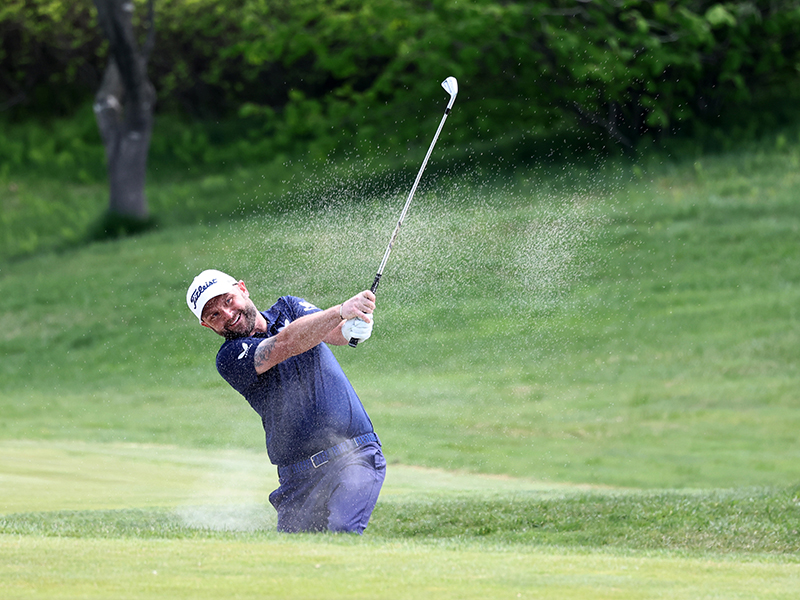This Bunker Shot Masterclass Changed Everything For Me... I Feel Like A Sand-Saving Machine!
I used to find bunker shots daunting, as finding the sand would often seriously damage my scorecard, but this professional masterclass changed everything...

Jeremy Ellwood

Hitting multiple bunker shots without escaping the sand is one of the most frustrating and embarrassing things that can happen on the golf course, but not understanding how to properly play a bunker shot is a problem that so many golfers experience.
I will admit that I didn't spend as much time practicing bunker drills as I perhaps should have done, and I fell into the popular golf trap of being more interested in how far we hit our 7-iron while ignoring the obvious flaws in our short-game skillset. But, that sentiment is now a thing of the past.
Investing in the best wedges on the market surely couldn't hurt, but I also made a proactive decision to remedy my sand trap woes. After investing some time researching the best bunker tips, I came across an incredible masterclass from none other than five-time DP World Tour Winner Andy Sullivan - and it changed everything...
Andy Sullivan's Bunker Shot Masterclass
Bunker shots can fill club golfers with dread, and one of the key problems is that they haven’t worked out how to get the club entering the sand consistently in the same place.
The best players on tour consistently enter the sand at the same point, whether they are playing the high shot, the low one or whatever.
Many club golfers also believe you have to open everything up, then cut across the ball, but I think that’s such a misconception because if you’re cutting across it, you’ll be hitting the ball out of the toe most of the time.
The ball’s not going to go forward then, it’s just going to glance off to the right. It’s probably a result of watching Seve over the years, but without being rude, he was a bit more talented than most handicap golfers! So open the face, yes, but I would much rather you then went straight back and through.
Subscribe to the Golf Monthly newsletter to stay up to date with all the latest tour news, equipment news, reviews, head-to-heads and buyer’s guides from our team of experienced experts.
Here, I’ll show you how to achieve greater consistency and offer some tips to help with the trickier lies you may encounter...
1. Ball Position
For me, my ball position is always on the left heel because it generally helps you to pop the ball up more easily when it’s forward in your stance, and the ball will land more softly too.
Anything in the middle or towards the back will come out lower and with more forward drive, which is usually not what you want in a greenside bunker. If I did want to drive it forward more, I’d move the ball back just a fraction, but it wouldn’t be in the middle – it would be a very subtle change.

Andy Sullivan has a 60% sand save success rate so far in the 2024 DP World Tour season
2. Consistent Point Of Entry
When I’m practising, I’ll draw a line in the sand with my club and try to hit that line, so my entry point is consistent. That guarantees the strike and you can then hit it low, play it high or whatever.
Start with the strike, and you can then vary your shots from there. The key part to being a good bunker player is to take a similar amount of sand every time, and this line exercise will help you to consistently find that ideal strike point.
If you then want to hit one high, you need to get your hands lower and get lower down to the ball, as that creates a steeper angle of attack and more loft. But do that through set-up rather than changes to your swing as it becomes more technical then than it needs to be.
3. Upslopes And Downslopes
The problem most amateurs have is that they don’t use the slope correctly. To succeed on upslopes and downslopes you’ve got to mirror the slope in your stance, rather than ‘fight’ it.
On an upslope, you must not lean into the slope because all your weight will be on your lead side and you’ll be too steep into the ball. Striking it well becomes much more difficult.
The key is to mirror the slope with your set-up, and then after that, keep everything the same as on a flat lie. It’s all about using the angle of the slope. The opposite, of course, applies on downslopes. You’re almost trying to keep the angle of your spine at right angles to the slope you’re on.

Sullivan currently ranks 31st for scrambling on the DP World Tour
4. Ball Above Or Below Feet
If the ball is above me, I’d go down the grip a little so it almost feels the same at address as it would on a flat lie. Conversely, if the ball is below me, I’d just go up the grip.
Your posture will change a little as a result. You’ll be more upright with the ball above you, and more angled over with it below you, but everything else should remain the same – ball off the left heel and then hitting that line at impact.
Remember that if the ball is above you, generally it’s going to come out a little to the left so you’ll need to aim the clubface a bit more to the right at address, and vice versa when it’s below you.
5. The Plugged Lie
It’s the one we all dread, and I’ve seen many suggestions for how best to tackle it. I quite like playing normal bunker shots with an open face, but with the plugged lie I’ll square the face up and then almost feel like I’m leaving the club in the sand at impact, with virtually no follow through.
I’ve found that the ball just pops straight out then. Of course, you know it’s going to release much more and you’re never going to get spin out of a plugged lie, so if you’ve short-sided yourself, you’re just going to have to accept a longer putt.
Sometimes when it’s plugged, people tend to decelerate a little, but if you think about leaving the club in the sand at impact, you’re putting all your emphasis on getting the ball out. The way I practise it is by almost trying to recoil at impact – you get the club in there in the sand and are then almost trying to pull it out instantly, so all the momentum is where it needs to be.

As referenced earlier, gripping down the club can help you escape the sand unscathed
6. Fairway Bunker Shots
Again, I think there’s a big misconception about fairway bunker shots, as many golfers will put the ball back in their stance to try and guarantee the strike. But most of the time you’ve got some kind of lip to go over, and if you do that it’s only going to come out lower. You might guarantee the strike, but you are making the shot more difficult.
The first thing I do is go down the grip a little, which again helps with the strike. Then, I almost want to feel like my head is rising a little so I’m gaining height just a fraction, as that makes me feel as though I can clip it a bit more at impact.
Many golfers lose a bit of height on the downswing with a tendency to hit it a little fat, and from a fairway bunker that’s bad news as even a little too much sand will rob you of distance. So go down the grip, gain a bit of height and clip it away.
Going down the grip will cost you some distance too, so it’s wise to club up. You’re also more likely to swing a little smoother, which again helps with the strike.
Want To Read More Expert Golf Tips?
The Golf Monthly archive is a treasure trove of brilliant reads, documenting a nostalgic journey through the history of golf, dating back to our first issue in 1911. Capitalise on over 100 years of expert tips from some of the best tour professionals and coaches in the world, by subscribing to the online Golf Monthly Archive.

Baz joined Golf Monthly in January 2024, and now leads the instruction section across all platforms - including print and digital. Working closely with Golf Monthly's Top 50 Coaches, he aims to curate and share useful tips on every aspect of the game - helping amateurs of all abilities to play better golf. Baz also contributes weekly to the features section, sharing his thoughts on the game we love and the topics that matter most. A member at Sand Moor Golf Club in Leeds, he looks forward to getting out on the course at least once a week in the pursuit of a respectable handicap.
Baz is currently playing:
Driver: Benross Delta XT
3-Wood: Benross Delta XT
Hybrid: TaylorMade Stealth 4 Hybrid
Irons: Benross Delta XT 5-PW
Wedges: TaylorMade RAC 60, Callaway Jaws MD5 54
Putter: TaylorMade Spider Tour
- Jeremy EllwoodContributing Editor